I’ve long wanted to write a recommended periodical list, but am well aware that would be an exercise in futility. Don’t most of us, after all, get most of our info from the internet? I know I certainly do.
Yet once upon a time I, like you, had to rely upon the printed word for edification and entertainment. What follows is an overview of several magazines, self published “zines,” catalogs and other ephemera that fortified me during the past decade. Covering horror—and all manner of weirdness—in literature and film, the following influenced me immeasurably, and by extension this web page.
But the purpose of this survey isn’t mere nostalgia. Below you’ll find a slew of wild, goofy, unpredictable and absolutely first rate reading. All the publications outlined below are well worth tracking down, and all come highly recommended. In alphabetical order, they are…
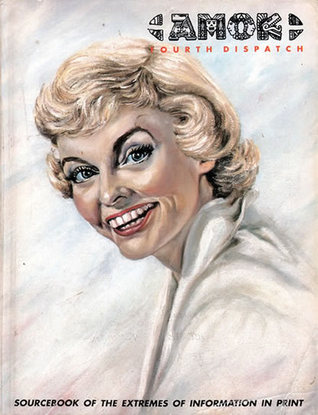 THE AMOK FOURTH DISPATCH
THE AMOK FOURTH DISPATCH
For years this massive catalogue, issued in 1990 or ‘91, was my one-stop guide for weird and/or obscure books. A showcase for the “extremes of information in print,” it contained entries for literally hundreds of whacked-out tomes, from torture manuals to cyberpunk novels.
I was smart enough not to use the final page order form, as quite a few of the listings were long out of print when this catalog was issued (I know many people did try and order books from it—and were sorry). I always viewed it as, in the words of John Waters’ back cover blurb, a “reading list from Hell,” and tracked down the books listed on my own. Incidentally, I’m assuming there were first, second and third dispatches, but I never got a hold of them. I know a fifth dispatch was issued, but I passed on it. The reason? Its issuers didn’t bother including a fiction category—a HUGE mistake, as in my view the fiction listings of the Fourth Dispatch were among its most vital.
Amok, for those who don’t know, was/is an underground publishing company, and operated one of the all-time cool bookstores. That store was initially located in Silverlake and then Los Feliz, and finally in one of the skuzzier sections of downtown LA. It is, needless to say, long gone now.
ANSWER ME!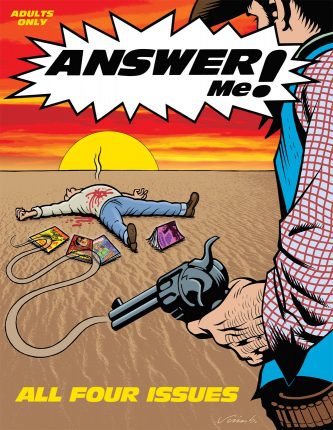
There were quite a few “transgressive,” “envelope-pushing” publications during the nineties, but none more so than Answer Me!, an outrageous, profoundly disturbing and plain ugly zine courtesy of Jim and Debbie Goad. I know many people claim the Goads’ intent was satiric, but I’m not entirely sure about that. What gives Answer Me! its edge is the fact that it’s difficult to discern whether these two are sophisticated satirists or social deviants.
Issues 1-3 (later issued as a book) were edifying but also plenty repellant, with info on serial killers, Ray Dennis Steckler movies, the possibility of Steven Spielberg being a pedophile, etc., all done with characteristic bile-spewing rage. The fourth and final issue is something else entirely: it may be the most offensive thing I’ve ever read, with lovingly detailed articles on rape, molestation and murder.
Since then Debbie Goad has died and Jim has done time for battering his girlfriend. Such hardship couldn’t have befallen a nicer couple of folks!
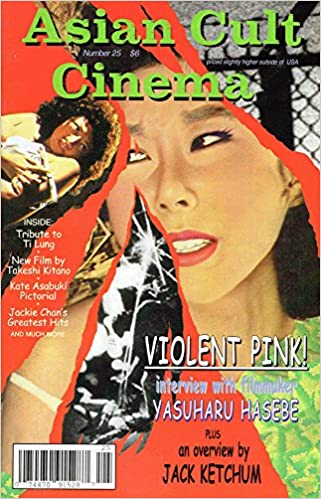 ASIAN TRASH/CULT CINEMA
ASIAN TRASH/CULT CINEMA
There have been several periodicals devoted to Asian cult cinema, but this is the one to read, a colorful book sized rag, originally titled Asian Trash Cinema, and then Asian Cult Cinema. It featured insightful reviews and commentary, and columns by critic Ric Meyers and novelist Max Allan Collins. ACC folded in 2010, FYI, although I’ll admit I largely stopped reading it once my subscription ran out in late ’99.
BEN IS DEAD
In my view the best of the thousand or so punk zines that flooded the LA area during the nineties. Ben is Dead explored the alternative music scene with gusto, yet had a disarmingly sweet, quirky edge. This was courtesy of editor Darby (if she ever gave a last name I’ve forgotten it), who didn’t try and affect the kind of phony “fuck you” stance of most punk enthusiasts. Nor was Darby unafraid of alienating her more hardcore readers, who were likely ticked by an admiring write-up on Weird Al Yankovich.
Stand-out issues included one called “Gross,” a fun and, yes, gross overview of disgusting music, movies and bodily fluids, and the multi-issue “Retro-Hell,” which flashed back on many seventies and eighties-era Gen-X staples (Dixie cups, early Jackie Chan movies, BUCKAROO BANZAI, etc.), and whose contents later saw print as a book.
BLACKEST HEART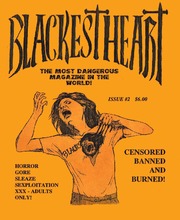
This mean-as-fuck zine was vile, bad tempered and misogynistic—and damned if I didn’t love every page! I eagerly devoured all three issues, and was very disappointed that a fourth never materialized.
Blackest Heart was a lot like Gore Gazette (see below), only several dozen times nastier. Articles of note included “Wipe Your Ass with Film Threat,” “Ann Landers: Anal Whore” and (my personal favorite) “If More Nuns were Lesbians I Might Go to Church.”
Seriously, though, what this too-short lived periodical did particularly well was capture what glossier rags like Spy and Esquire have tried very hard (and failed) at: guy talk, rendered without censorship or apology. Real guy talk is, like this mag, sharp, nasty and politically incorrect—and probably shouldn’t be taken too seriously.
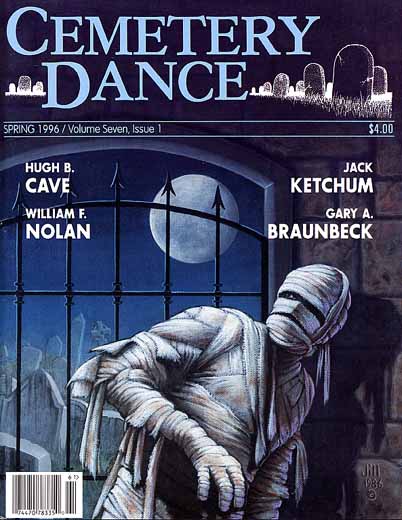 CEMETERY DANCE
CEMETERY DANCE
Quite simply the premiere horror fiction magazine of the nineties and beyond. All the top names in the field appeared at some point in Cemetery Dance (King, Campbell, Ketchum, etc.), as well quite a few lesser known but equally potent talents. Yes, Cemetery Dance contained the expected reviews, interviews, articles, etc., but it worked primarily because of its unwavering focus on good fiction, of which each issue contained a goodly amount.
CINEFANTASTIQUE
A slicker-than-average sci fi/horror/fantasy film mag (now an e-zine), but one with a definite point of view—i.e. unafraid to bite the hand that feeds it! It also contains in-depth features on the flicks it covers, as opposed to the brief studio-approved write-ups you get in most movie mags.
Full disclosure: I prefer the earlier issues of Cfq—from the seventies, eighties and early nineties—to the more recent ones…and don’t even get me started on Cfq’s pathetic offshoots Imagi-Movies and Femme Fatales.
THE DARK SIDE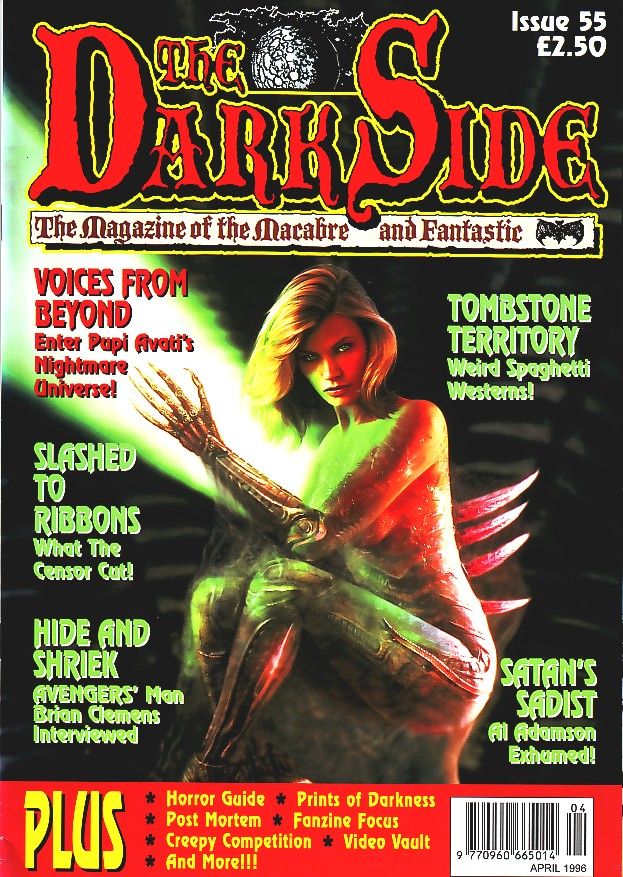
A colorful British mag devoted to cultish and horror cinema that illuminated quite a few once-obscure subgenres, particularly the Italian Spaghetti Western cycle—in which an article from The Dark Side first piqued my interest.
DEEP RED
One of this overview’s quirkier listings. Deep Red, a horror/gore movie mag, is the idiosyncratic brainchild of the fiercely independent Chas Balun, who puts out a new issue every now and again, though not on any kind of fixed schedule.
Equally mercurial are the films covered by Deep Red. The mag started in the late-eighties, when other genre rags were covering NIGHTMARE ON ELM STREET sequels; Deep Red, by contrast, lavished its attention on the likes of COMBAT SHOCK and DR. BUTCHER M.D. The mag was also an early and vocal supporter of the fiction of the great Jack Ketchum. Such staunch nonconformity is rare and salutary. So too the writing by Chas and others, which is spirited and fan-based.
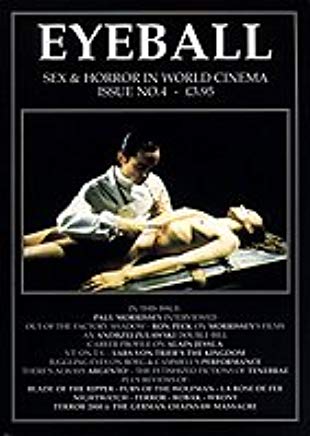 EYEBALL
EYEBALL
Another British horror/cult movie mag that once claimed my attention. Eyeball was particularly hard to come by the US, but the few issues I managed to procure remain treasured relics. One of them contains a lengthy write-up on and interview with the Polish filmmaker Andrzej Zulawski, which remains a key resource for fans of this undeservedly obscure genius.
FANGORIA
The only publication listed here that was around when I was a kid and is still in the running. Well okay, the near 40-year-old Cinefantastique remains extant online, but I’ve largely lost interest. Fangoria on the other hand remains a big draw. I’ll acknowledge that many of the criticisms people like to throw at Fango are valid: it focuses overmuch on shitty sequels and remakes, and the writing too often seems aimed at a ten year old mentality. But Fangoria, to use an overworked expression, definitely has its finger on the pulse of the horror community. Being very much of that community, I can’t help but pay attention.
FEAR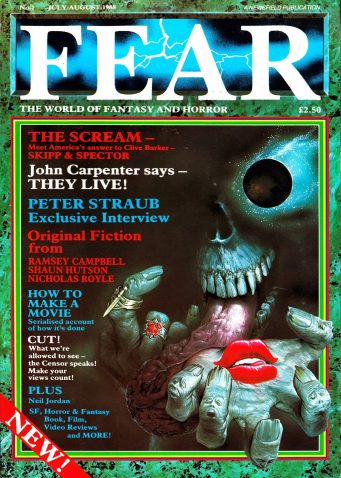
Very likely the best horror mag of the past decade: knowledgeable, opinionated and all-inclusive. It explored horror-themed films and books with equal aplomb in quite a few essential articles, reviews and interviews with the top names in the field. Fear was a British publication, meaning it was difficult to find on these shores. Whenever I did manage to track down an issue, though, I always made a point of grabbing it—and was always left feeling enriched.
FILM THREAT VIDEO GUIDE
This periodical, an offshoot of Film Threat, explored the underground film scene with candor and enthusiasm. It was through FTVG that I first became acquainted with off-off Hollywood filmmaking, so for that, if nothing else, it deserves a nod. FTVG also distributed must-have films like RED AND ROSY, TRIBULATION 99 and NEKROMANTIK on VHS (back then the DVD revolution was still a ways off).
As for Film Threat itself, I was never that enamored with it. I’d put it on the same level as its chief “rival” Premiere, in that I’d buy an issue now and then if some article/review/interview caught my eye, but for the most part I tended to pass it by. Film Threat never seemed too threatening, and by the mid-nineties had grown downright annoying, catering to somebody’s idea of a Generation X demographic with indifferently written articles about, essentially, nothing. (To be fair, the pre-1991 issues of FT actually delivered the sharpness promised by the title, but I didn’t discover those until long after the mag had entered its glossy phase, and by then the damage had been done.)
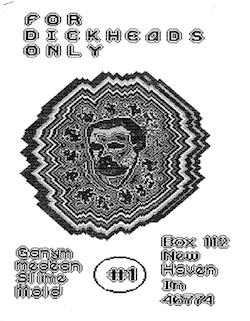 FOR DICKHEADS ONLY
FOR DICKHEADS ONLY
A handmade zine dedicated to Philip K. Dick. These days you can find more than enough PKD info on the web, but in the early nineties this was the premiere resource for Dickheads.
I’m not sure how many issues were printed. I’ve got the first three, all of which are solid compendiums of reviews of Dick’s books, biographical info on the man, and various other fun stuff (including PKD crossword puzzles).
FUNERAL PARTY
Issued as two large format 1990s-era paperbacks, Funeral Party, edited by Shade Rupe, explored nearly all things weird and/or scary. Featured were interviews (most of which were later collected in the book DARK STARS RISING) with Jack Ketchum, Chas. Balun, the “Torture King,” EXTREMITIES writer William Mastrosimone and other interesting folks, along with plenty of freaky artwork and photographs. Fun!
GAUNTLET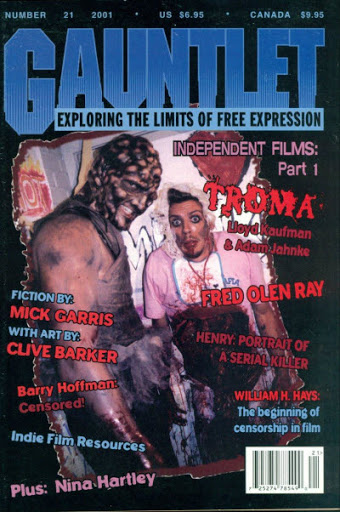
These days Gauntlet is known as an independent publisher. Too few folks are aware, however, that the label began as a magazine dedicated to “Exploring the Limits of Freedom of Expression.” Gauntlet, which lasted from 1990 to 2003, was never very widely read, and that’s a shame, as it was among the most provocative periodicals on the scene. While staunchly anti-censorship, Gauntlet was also frank about the fact that free speech is a far pricklier and more complicated issue than something like the smarmy “Free Speech Week” (in which we’re encouraged to pat ourselves on the back for saving HUCKLEBERRY FINN and CATCHER IN THE RYE from the flames) would have us believe.
Editor Barry Hoffman fearlessly and unflinchingly explored the wildest, freakiest reaches of Americana, including pornographers, prostitutes, environmental and animal rights activists, out-of-control politicians, etc. The point, of course, was if we’re to have freedom of speech it has to apply to everyone, even the freakiest of us. Most people, I’ve found, take the view “I believe in free speech, but…” It was Gauntlet’s mission to illuminate that “but…”
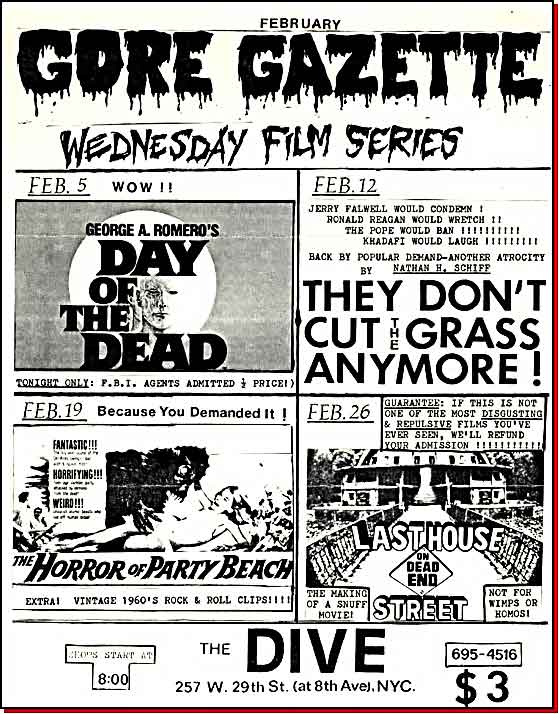
Thanks to www.JRHI.com
GORE GAZETTE
In many ways the granddaddy of horror zines, a celebration of horror/exploitation cinema from the late New York based Rick Sullivan that began sometime in the early eighties and lasted until 1994. I didn’t get to it until 1991 or ’92 (when it began appearing on the Tower Records magazine racks), but since then I’ve been exploring the 100-plus back issues.
The Gore Gazette was the anti-Fangoria: rude, funky, foul-mouthed and funny as shit. Sullivan’s voice was a unique and instantly recognizable one, a bit like the genre’s answer to Howard Stern. I’m mighty sorry he’s no longer around.
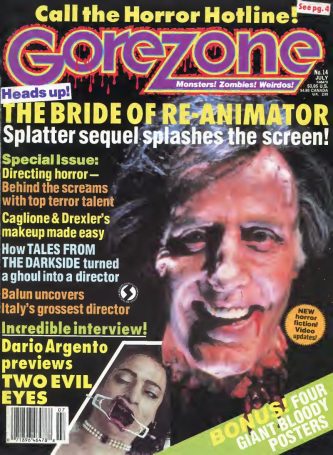 GOREZONE
GOREZONE
The sister publication of Fangoria, and an even better mag overall. It had a funkier vibe, with a more independent-minded focus—it even featured a column by Chas. Balun. Of course it didn’t last very long!
JOURNAL WIRED
This literary journal, co-published by bookseller/publisher Mark V. Ziesing, only had three installments, but they were memorable ones. Featured were in-depth interviews with writers like William Gibson and Iain Banks, a top-of-the-voice column by the inimitable Lucius Shephard, and original fiction by quite a few fine writers. Among the latter was a young Jonathan Lethem, who I never forgot after encountering his work for the first time in Journal Wired.
THE KEELER NEWS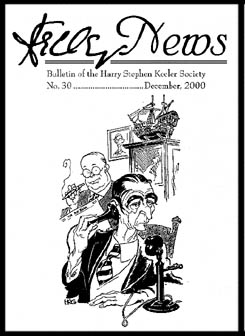
A neat little zine devoted to the late Harry Stephen Keeler, the wackiest mystery writer of all time. I’m fully aware that not everyone will be interested in HSK’s correspondence with Anthony Boucher, or the annual Imitate Keeler competition, but for Keeler-philes (which I most certainly am) TKN is a veritable goldmine.
THE MARK V. ZIESING CATALOG
In the days before the internet, Mark V. Ziesing was the go-to guy for books you couldn’t get through mainstream channels. He ran a mail-order business for which he put out a one-of-a-kind catalog.
I came in on said catalog in 1991, with issue #94, and stayed with it for the next thirty or so installments. Oftentimes I’d order books from Mark just to keep the catalogs coming.
These catalogs were utterly unique, packed with voluminous info on various rare books. Mark has a definite talent for spotlighting the strangest and most intriguing tomes imaginable (in this regard he was second only to the Amok Fourth Dispatch outlined above). Plus his catalogs had a personal touch that was unmistakable (Mark’s introductory rants were priceless) and a real homemade charm.
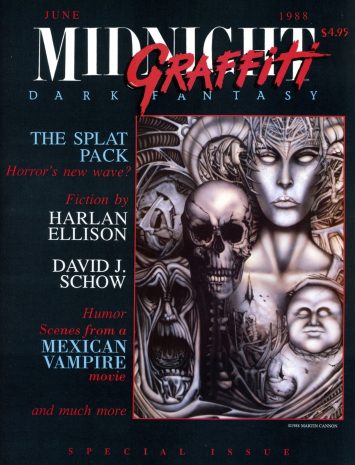 MIDNIGHT GRAFFITI
MIDNIGHT GRAFFITI
One of several horror-themed fiction magazines that appeared in the wake of The Twilight Zone Magazine’s dissolution, Midnight Graffiti was itself very Twilight Zone-ish, only tougher, meaner and more horror-focused. It only lasted a few years, but they were fulfilling ones: MG published two of my all-time favorite stories, David J. Schow’s “Bad Guy Hats” and Steven R. Boyett’s “Emerald City Blues,” and a transcript of an incredible 1985 radio conversation between Harlan Ellison and Clive Barker, which I’ve quoted from more times than I can count.
MURDER CAN BE FUN
That title (taken from a Frederick Brown novel) is misleading. This zine, written and published by Johnny Marr, was a literate and erudite look at interesting fiction (Charles Willeford, Cornell Woolrich and Jim Thompson were all lovingly profiled), disasters and famous crimes. Of the first ten issues Marr now says “they weren’t that good anyway.” I beg to differ! It was in MCBF that I first learned of the late Sylvia Lykens and her horrific fate and the loony fiction of Harry Stephen Keeler (see The Keeler News, profiled above). Also included in MCBF was Marr’s essential “Read Hard or Die” book review section. More fun was had in an issue entitled “I Hate Sports!” and a daring take on the infamous Irish cannibal Sawney Beane, who Marr (convincingly) argues didn’t actually exist!
NECROFILE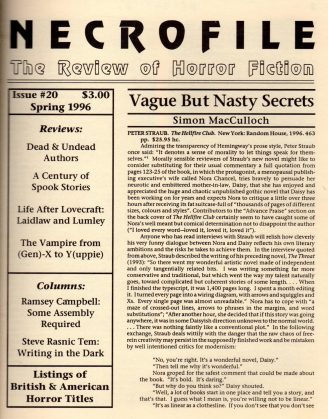
Along with Cemetery Dance and Tekli-Li!, Necrofile was THE place to go for literate and knowledgeable info on horror fiction. Its reviews were voluminous, and far more in-depth than most. Plus it ran informative columns by Fred Chappell and Ramsey Campbell.
NIGHT CRY
I shamefully ignored this short-lived digest-sized mag when it was on newsstands during 1985-87…and so have spent the succeeding years scrambling for back issues. This for me makes Night Cry a nineties publication, since I never really bothered reading it before. It was an offshoot of The Twilight Zone Magazine focusing strictly on horror. In other words, it was precisely what I feel TZ should have been—or, put another way, Night Cry was like TZ only better!
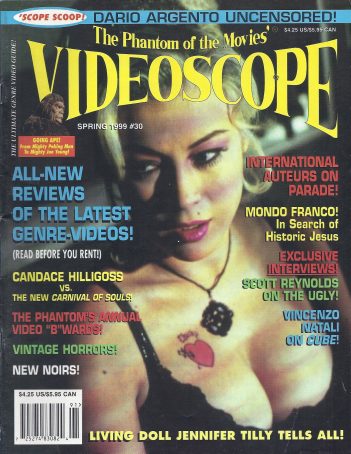 THE PHANTOM OF THE MOVIES’ VIDEOSCOPE
THE PHANTOM OF THE MOVIES’ VIDEOSCOPE
Another mag I’ve stopped reading in recent years, although for a time I enjoyed it immensely. It contains reviews of various horror and cultish flicks by “The Phantom” (a.k.a. New York Daily News columnist Joe Kane) and several other writers, along with the requisite interviews and features. Of course it can’t hold a finger to Shock Cinema (the publication it most resembles), which is probably why I no longer bother with it.
THE RED NEWSLETTER
Surely you know of the legendary “Red Tape”? It’s the Holy Grail of prank phone calls, being a series of taped calls to a New Jersey watering hole called the Tube Bar. The hot-headed proprietor, a guy named Red, answers the phone each time, and the callers get him (very) wound up. Sample response: “Ya lousy muthuh-fuckuh cock-suckuh!! Why don’cha come down here ya fuckin’ bum?? I’ll cut ya belly open!!!”
This newsletter was put out by the Red Fan Club (of which I was a proud member), and featured info on the tape’s origins and explanations of many of Red’s more esoteric utterances (like the term “Z.Z.,” which was apparently old-time gangster slang). It also contained a classified section that among other things had info on a planned “pilgrimage” to the Tube Bar. I wanted very much to go, but unfortunately the Newsletter only lasted two issues, and the pilgrimage (as far as I know) never occurred. Bummer.
RE/SEARCH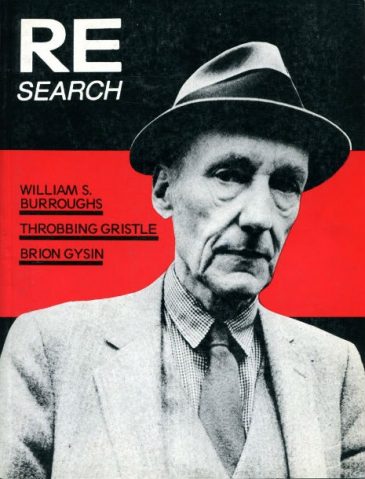
Not merely a publishing company, but a trusted brand name and attitude unto itself.RE/Search began as a San Francisco based periodical that grew into a series of large format paperbacks on subjects like William Burroughs, J.G. Ballard, the Survival Research Laboratories, bodily fluids, weird music, and (in the pioneering volume INCREDIBLY STRANGE FILMS) cult movies. RE/Search also reissued classic novels like THE ATROCITY EXHIBITION and THE TORTURE GARDEN in eye-popping illustrated editions.
The format and layout of these books, courtesy of publishers/editors/lovers V. Vale and Andrea Juno, was utterly unique and distinctive. For a time RE/Search actually accomplished what every fringe publisher secretly dreams of: it brought alternative culture into the mainstream, and to the attention of squares like me.
That all ended, alas, when Vale and Juno broke up in the mid nineties. Sure, the two continued publishing like-minded books under the imprints V/Search and Juno Books, but the magic was gone (although V/Search’s publication of Daniel P. Mannix’s MEMOIRS OF A SWORD SWALLOWER is a must).
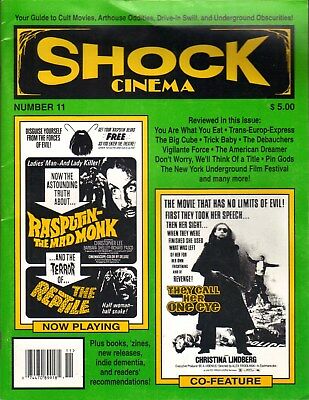 SHOCK CINEMA
SHOCK CINEMA
My discovery of issue #4 of Shock Cinema during a 1992 trip to New York City was a revelation. It was the first of the cult movie mags—including Filmfax (which I found too slick), Video Watchdog (too nerdy), Cashiers du Cinemart (too uneven), Famous Monsters of Filmland (too old mannish) and Psychotronic (too pleased with itself by far)—that really resonated with me. Edited and largely written by Steve Puchalski, it was admirably straightforward and unaffected in its approach, and covered everything from forgotten Hollywood horrors to obscure foreign films.
But getting back to that fateful NYC trip, I was happy to have stumbled upon Shock Cinema, as back then it was difficult to come by. These days you can get it at any good newsstand, yet it retains all the verve and individuality that initially drew me in (and yes, I now write for it, but don’t let that put you off).
A little trivia: I once seriously considered putting out a cult movie zine of my own, but scrapped that idea upon concluding that my prospective zine would very likely look and read a lot like Shock Cinema, but probably wouldn’t be as good. And if you can’t beat ‘em join ‘em!
SHOCK XPRESS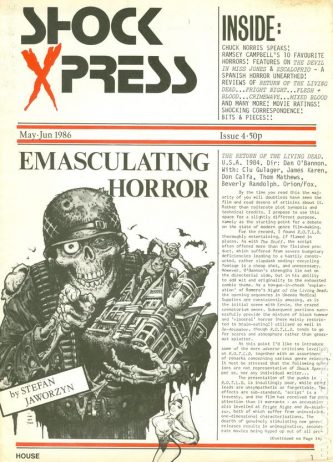
A British mag that was compressed into two book length compilations that appeared in the mid nineties. Focused on horror/cult cinema, these were priceless packages, packed with interesting articles and interviews by top names like Ramsey Campbell, Kim Newman, Stephen Jones and many others. It was through Shock Xpress that I first learned of obscure gems like MY FRIENDS NEED KILLING and FREAK ORLANDO, the work of Walerian Boroczyck, and the appalling “films” of Steven Poster.
SIGHT AND SOUND
A surprise: going through my old magazines I found dozens of back issues of this long-running British film rag. I’m not too enamored of it these days but was evidently quite the fan back in the mid-to-late nineties. I’ll say this for Sight and Sound: it’s reliable, with a never-changing layout and attitude. True, that attitude is a mite highbrow (given the choice between an Andrei Tarkovsky retrospective and one by George Romero, it’s a safe bet S&S will go with the Tarkovsky), but at least with S&S you know exactly what you’re getting.
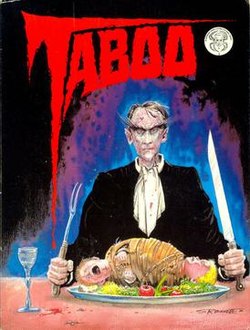 TABOO
TABOO
A graphic journal edited by the famed “cineterologist” and graphic artist Stephen Bissette. Taboo went through 7 or 8 installments, and featured comic book tales from quite a few top artists, scripted by just as many top writers. Of course, as the title makes clear, the contents are strictly of the adults-only variety. Particularly memorable contributions include several chapters from the (then still in progress) Alan Moore/Eddie Campbell masterpiece FROM HELL, a selection of mesmerizingly repugnant drawings from the demented S. Clay Wilson and (a major coup) the first English language publication of Alejandro Jodorowsky and Moebius’ legendary EYES OF THE CAT.
Truly a one-of-a-kind journal from a one-of-a-kind editor.
TEKLI-LI!
For those wanting a serious and scholarly approach to horror fiction, Tekli-Li! was a great place to look. This jam-packed publication contained knowledgeable tributes to the authors Joseph Citro and Thomas Ligotti, along with the expected array of interviews, essays and reviews.
THE TWILIGHT ZONE MAGAZINE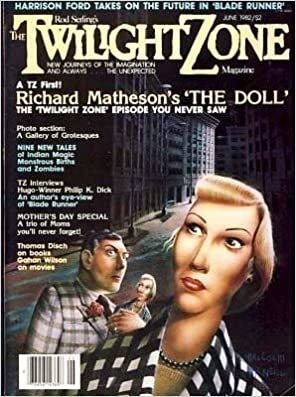
Once my favorite magazine, this is one of the oldest publications listed here (it closed up shop back in 1988), but its influence on my writing cannot be underestimated. My feelings about TZ are mixed these days. Certainly I like and admire its overseers’ commitment to quality fiction, but the mag was a bit all-over-the-place tonally. The problem, I believe, is that nobody has ever adequately defined just what the hell “Twilight Zone” is supposed to mean, and so TZ tried to encompass horror, fantasy and science fiction. It’s also a bit overly mainstream for my tastes. Once again, the problem seems to be a lack of focus; rather than target a single demographic, TZ tried to hit ‘em all.
Still, I worshipped TZ as a youngster. Without it this survey very likely wouldn’t exist, but I’m really glad it does, as it was great getting reacquainted with these terrific publications. Sadly, all but a handful are now dead and buried. Of those that aren’t, most—Cinefantastique, Murder Can Be Fun, The Keeler News, Gauntlet—are extant online. Needless to add, I strongly advise looking them up.
